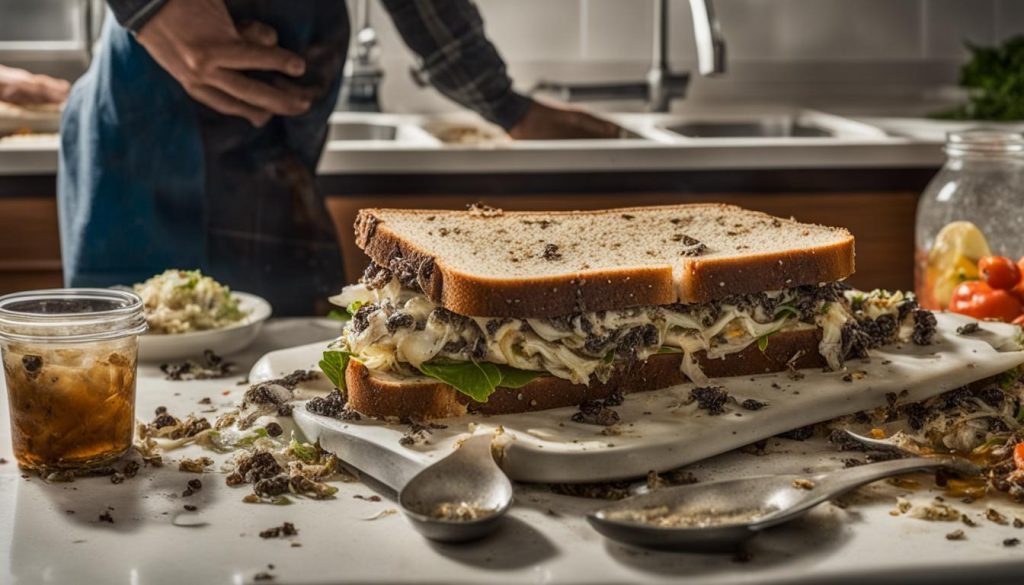Did you know that every year, an estimated 1 in 6 Americans (or 48 million people) experience a foodborne illness? That’s equivalent to the entire population of South Korea! Ensuring safe food handling and storage practices is crucial to prevent contamination and protect yourself and your loved ones from foodborne illnesses.
Key Takeaways:
- – Safe food handling and storage practices are essential to preventing foodborne illnesses.
- – Following proper guidelines and procedures minimizes the risk of contamination.
- – Maintaining cleanliness, optimizing storage conditions, and controlling temperatures are key steps in safe food handling.
- – Non-compliance with food handling regulations can have legal and reputational consequences.
- – Prioritizing food safety in your kitchen contributes to a healthier and safer environment.
Importance of Food Handling
Food handling plays a crucial role in preventing outbreaks of foodborne illnesses. Unsafe food handling can lead to the spread of bacteria and other pathogens that can cause long-lasting disability or even death. That’s why government agencies closely monitor food handling practices and enforce regulations to ensure public health and safety.
By following proper food handling techniques, individuals can significantly reduce the risk of contamination and safeguard their well-being. It is essential to implement effective measures to prevent foodborne illnesses and protect both individuals and communities.
Businesses that prioritize food safety build trust with customers and avoid potential legal consequences. By adhering to food safety regulations, companies demonstrate their commitment to providing safe and high-quality products. Compliance with these regulations not only protects the public but also safeguards the reputation and sustainability of the business.
In light of the potential dangers associated with unsafe food handling, it is crucial for individuals and businesses alike to acknowledge the importance of proper food handling practices. By doing so, we contribute to a safer and healthier environment for everyone.
Food Handling Drives Public Health and Safety
Ensuring food safety is not just a matter of personal responsibility but also a critical public health concern. Improper food handling practices can lead to foodborne illnesses that can affect a large number of people in a very short time.
According to the Centers for Disease Control and Prevention (CDC), an estimated 48 million Americans get sick from foodborne illnesses each year, leading to over 128,000 hospitalizations and 3,000 deaths. These alarming statistics demonstrate the significance of food handling in maintaining public health and safety.
Government agencies, such as the Food and Drug Administration (FDA) in the United States, have established stringent regulations to prevent and control foodborne illnesses. These regulations cover all aspects of food handling, including proper hygiene, safe storage and preparation, and temperature control.
Preventing Contamination through Safe Food Handling
Proper food handling practices are designed to prevent contamination, which occurs when harmful bacteria or other pathogens come into contact with food. Contamination can happen at any stage of the food handling process, from production and processing to distribution and preparation.
By implementing strict hygiene practices, such as frequent handwashing, wearing gloves, and maintaining clean utensils and surfaces, individuals can significantly reduce the risk of contamination. Separating raw and cooked foods, avoiding cross-contamination, and correctly storing food at appropriate temperatures further mitigate the chances of harmful bacteria multiplying and spreading.
Following food safety regulations ensures that businesses take necessary precautions to prevent contamination. These regulations often include regular inspections, proper training of staff, and maintaining records of food sources and handling practices.
Building Trust and Avoiding Legal Consequences
Businesses that prioritize food safety and comply with regulations build trust and confidence among customers. By showcasing commitment to safe food handling practices, companies establish themselves as reliable providers of high-quality products.
Failure to comply with food safety regulations can have severe consequences for businesses. Apart from the potential harm to public health and the resulting damage to reputation, companies that do not adhere to regulations may face legal repercussions. Fines, penalties, and even criminal charges can be imposed on businesses that fail to maintain proper food handling practices.
By understanding and implementing the importance of food handling and complying with food safety regulations, individuals and businesses contribute to the collective effort in preventing foodborne illnesses, ensuring public health and safety, and maintaining trust and credibility.
Food Handling Regulations
In the United States, food establishments must adhere to the Food and Drug Administration’s Food Code, which sets the standards for safe food handling practices. This code establishes guidelines and requirements that businesses must follow to ensure the safety and quality of the food they serve.
Under the Food Code, each establishment is required to assign someone responsible for overseeing and verifying that employees are trained and following proper food handling practices. This helps to prevent cross-contamination, reduce the risk of foodborne illnesses, and maintain overall food safety.
Furthermore, the Food Safety Modernization Act (FSMA) introduced the Hazard Analysis and Risk-based Preventive Control (HARPC) regulation. This regulation emphasizes the importance of temperature control during various stages of food processing, such as cooking, cooling, and holding. By implementing these preventive measures, businesses can minimize the risk of microbial growth and contamination.
In Australia, another important regulation is the Food Standards Code, which requires food businesses to train their employees in food safety and hygiene. This code outlines the necessary steps to prevent food contamination, including proper handling, storage, and preparation of food. Compliance with the Food Standards Code is essential to ensure food safety standards are upheld in the country.
By complying with these food handling regulations, both in the United States and Australia, businesses can demonstrate their commitment to food safety and protect the health of their customers. These regulations serve as a framework for maintaining high standards and preventing foodborne illnesses.
Consequences of Poor Food Handling
Poor food handling practices can have serious consequences, including the risk of foodborne illness outbreaks. One such illness that commonly occurs due to contamination is norovirus, a highly contagious virus that causes vomiting and diarrhea. When food is mishandled, it becomes a breeding ground for harmful bacteria and viruses, posing a significant threat to public health.
Failure to follow proper food handling procedures can also have legal implications for businesses. A notable example is the case of Blue Bell Creameries, a popular dairy company that faced criminal liability and substantial settlements due to a deadly outbreak of Listeria linked to their products. This incident serves as a stark reminder of the importance of prioritizing food safety.
“Ensuring food safety should be a top priority for all businesses in the food industry. Negligence in food handling not only jeopardizes public health but can also result in severe legal consequences.” – Food safety expert
Implementing proper food handling practices is imperative to protect both consumers and businesses. By adhering to strict hygiene protocols, following storage guidelines, and ensuring thorough cooking and chilling, the risk of foodborne illnesses can be significantly reduced. Complying with food safety regulations not only safeguards public health but also helps businesses maintain their reputation and avoid legal troubles.
The Legal Implications of Foodborne Illnesses
When a foodborne illness outbreak occurs, affected individuals may pursue legal action to seek compensation for their injuries and losses. Victims can file lawsuits against the responsible parties, including food establishments, distributors, and manufacturers. Legal claims in food poisoning cases commonly seek compensation for medical expenses, lost wages, pain and suffering, and in severe cases, wrongful death.
Proving liability in foodborne illness cases can be complex, requiring thorough investigations and expert testimonies. The burden of proof lies with the plaintiff, who must demonstrate that the negligent food handling directly caused their illness. To avoid legal disputes and protect their reputation, businesses must prioritize food safety by adhering to proper handling, storage, and hygiene practices at all times.
Preventing Legal Consequences through Proper Food Handling
Businesses can take proactive measures to prevent legal implications by implementing comprehensive food safety programs. This includes staff training on proper food handling practices, regular inspections by health authorities, and thorough monitoring of storage and cooking temperatures. By prioritizing food safety, businesses can not only protect their customers but also safeguard their brand reputation and financial stability.
Overall, understanding the consequences of poor food handling is crucial for both individuals and businesses. By prioritizing food safety and compliance with regulations, we can reduce the risk of foodborne illnesses, protect public health, and ensure a safe and enjoyable dining experience for everyone.
Safe Food Handling Practices
When it comes to food safety, following proper handling practices is essential in preventing foodborne illnesses and ensuring the well-being of your family. By adopting the four key steps of clean, separate, cook, and chill, you can minimize the risk of contamination and maintain the safety of the food you handle and consume.
Clean
The first step in safe food handling is to maintain cleanliness. This involves washing your hands thoroughly with soap and water for at least 20 seconds before and after handling food. Clean all surfaces, utensils, and equipment used in food preparation to prevent cross-contamination. Regularly clean kitchen surfaces, cutting boards, and utensils with hot, soapy water or in the dishwasher. Keeping a clean kitchen environment is vital in preventing the spread of bacteria and other harmful pathogens.
Separate
Properly separating different food categories is crucial to prevent cross-contamination. Keep raw meats, poultry, and seafood separate from other foods, especially fruits and vegetables, to avoid the transfer of bacteria. Use separate cutting boards and utensils for different food groups to minimize the risk of cross-contamination. This practice is particularly important for individuals with food allergies or sensitivities, as it helps prevent the accidental transfer of allergens.
Cook
Cooking food to appropriate temperatures is another vital step in safe food handling. Use a food thermometer to ensure that meats, poultry, and seafood are cooked to safe internal temperatures. The recommended internal temperatures for different types of food are:
| Food Category | Internal Temperature |
|---|---|
| Dairy | 165°F (74°C) |
| Meat and Fish | 145°F (63°C) |
| Eggs | 160°F (71°C) |
| Fruit and Vegetables | N/A* |
| Frozen Goods | N/A* |
| Dried Goods | N/A* |
*Fruit, vegetables, frozen goods, and dried goods do not have specific internal temperature requirements. However, it is still essential to handle them properly to maintain their quality and prevent contamination.
Chill
Properly chilling perishable foods helps prevent the growth of bacteria that can cause foodborne illnesses. Store perishable items, such as dairy, meat, and fish, in the refrigerator at temperatures below 40°F (4°C). Keep eggs in their original cartons and store them in the main compartment of the fridge, not in the door where temperatures can fluctuate. Frozen goods and dried goods should be stored in airtight containers or sealed packaging in the freezer or pantry, respectively, to maintain their quality.
By following these safe food handling practices, you can protect yourself and your loved ones from foodborne illnesses. Remember to clean, separate, cook, and chill to maintain the safety and quality of the food you handle and consume.
Visit the FDA’s website to learn more about safe food handling guidelines and best practices.
Conclusion
Safe food handling and storage are essential practices to ensure food safety and prevent contamination, promoting the well-being of your family. By following proper guidelines and regulations, you can minimize the risk of foodborne illnesses and create a kitchen that prioritizes safety.
Maintaining cleanliness is crucial in preventing cross-contamination and the spread of harmful bacteria. Remember to separate different food categories to avoid potential contamination. Additionally, cooking food thoroughly and following appropriate temperature guidelines reduces the risk of consuming undercooked or unsafe meals.
Proper storage conditions are equally important to maintain the freshness and quality of your food. By adhering to optimal storage temperatures and guidelines, you can prolong the shelf life of perishable items and prevent the growth of bacteria. Remember that safe food handling and storage practices not only protect your health but also contribute to creating a healthier and safer environment for everyone.
For more information on safe food handling and storage guidelines, visit the Department of Agriculture’s Food Safety website and educate yourself on the best practices for a safe and secure kitchen.


